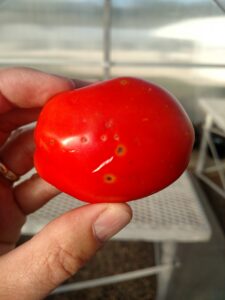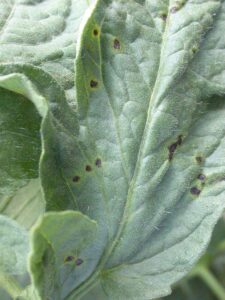The following is an article in one of a series about bacterial diseases of tomato. Previously, articles about bacterial canker and bacterial spot have been featured here. The next article will be about general management methods for bacterial diseases of tomato.
Bacterial speck causes lesions on all above ground portions of the tomato, in a similar fashion to bacterial spot. Lesions tend to be round and water-soaked under moist conditions. Lesions on fruit are rarely more than 1/20 of an inch in diameter, making them usually smaller than lesions of bacterial spot (Figure 1). Mature lesions of bacterial speck tend to have chlorotic (yellow) halos around each lesion (Figure 2) in contrast to lesions of bacterial spot which tend to be associated with chlorosis only when present in sufficient numbers.
The optimum temperatures for bacterial speck are from 64-75°F. This is in contrast with the relatively warm temperature optimum for bacterial spot of 75-86°F. Thus, bacterial speck is often more active early in the season, whereas bacterial spot is more active later in the season.
The pathogen that causes bacterial speck also survives for a time on crop residue and on surfaces such as wooden stakes and transplant trays. Therefore, crop rotations of 2-3 years and field and greenhouse sanitation are part of the management recommendations.
Copper products may help to lessen the populations of the bacterial speck pathogen on leaf surfaces and slow the spread the disease from plant to plant. Actigard® is labeled for bacterial speck; use should be similar to that on bacterial spot. Products that may be used in some organically certified situations include LifeGard®, Regalia® and Serenade Opti®.
The fungicide Tanos® has shown some efficacy against bacterial spot; use should concentrate on applications which will also treat possible fungal diseases.
If bacterial spot of tomato is typically a problem in your production, consider a variety that has host resistance.

